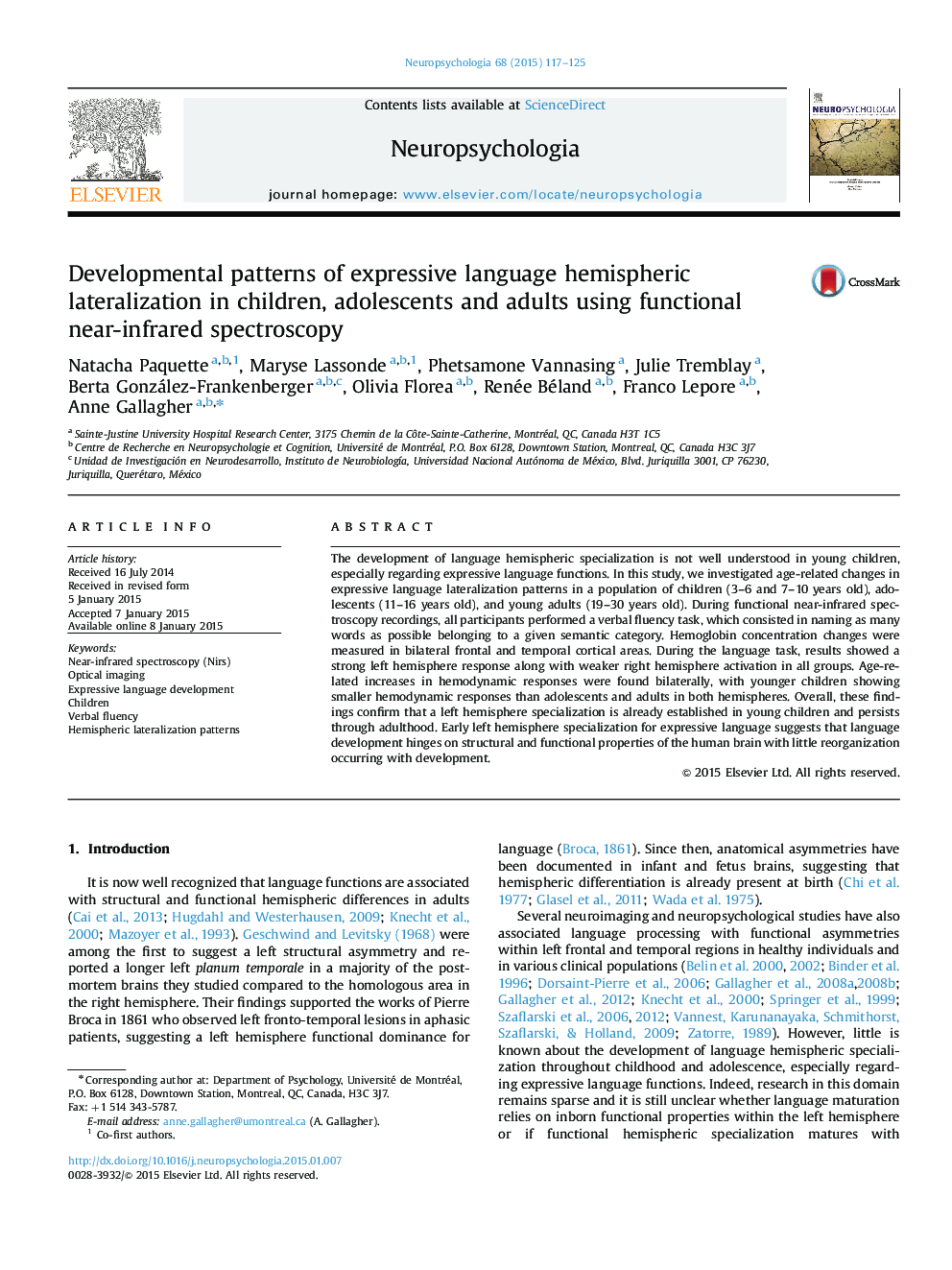| کد مقاله | کد نشریه | سال انتشار | مقاله انگلیسی | نسخه تمام متن |
|---|---|---|---|---|
| 7320445 | 1475585 | 2015 | 9 صفحه PDF | دانلود رایگان |
عنوان انگلیسی مقاله ISI
Developmental patterns of expressive language hemispheric lateralization in children, adolescents and adults using functional near-infrared spectroscopy
ترجمه فارسی عنوان
الگوی رشد زبان لاتین نیمکره ای زبان بیانگر در کودکان، نوجوانان و بزرگسالان با استفاده از طیف سنجی تابعی نزدیک به مادون قرمز
دانلود مقاله + سفارش ترجمه
دانلود مقاله ISI انگلیسی
رایگان برای ایرانیان
کلمات کلیدی
ترجمه چکیده
توسعه زبان تخصصی نیمکره ای به خوبی در کودکان جوان به خصوص در مورد عملکرد زبان بیان شده به خوبی درک نمی شود. در این مطالعه، تغییرات مربوط به سن در الگوهای لختی زبان بیانگر در جمعیت کودکان (3-6 و 7-10 ساله)، نوجوانان (16-16 ساله) و بزرگسالان جوان (19-30 ساله) مورد بررسی قرار گرفت. ) در طول ضبط های اسپکتروسکوپی نزدیک به مادون قرمز، همه شرکت کنندگان یک وظیفه فلسفی کلامی را انجام دادند که شامل نام گذاری به عنوان بسیاری از کلمات به عنوان متعلق به یک دسته معنایی معین بود. تغییرات غلظت هموگلوبین در ناحیه قشر دو طرفه و قشر جانبی اندازه گیری شد. در طول کارکرد زبان، نتایج نشان داد که پاسخ نیمکره چپ قوی همراه با فعال شدن نیمکره راست ضعیف در همه گروه ها است. افزایش سن پاسخ های همودینامیک در دوزهای مختلف یافت می شود، در حالی که کودکان جوانتر پاسخ های همودینامیکی کمتر از نوجوانان و بزرگسالان در هر دو نیمکره دارند. به طور کلی، این یافته ها حاکی از آنست که تخصص نیمکره چپ در کودکان قدیم تاسیس شده و از طریق بزرگسالی ادامه می یابد. تعلیم نیمکره ی اولیه ی زبان بیانگر آن است که توسعه ی زبان بر ویژگی های ساختاری و عملکردی مغز انسان با تغییرات اندکی در جریان است.
موضوعات مرتبط
علوم زیستی و بیوفناوری
علم عصب شناسی
علوم اعصاب رفتاری
چکیده انگلیسی
The development of language hemispheric specialization is not well understood in young children, especially regarding expressive language functions. In this study, we investigated age-related changes in expressive language lateralization patterns in a population of children (3-6 and 7-10 years old), adolescents (11-16 years old), and young adults (19-30 years old). During functional near-infrared spectroscopy recordings, all participants performed a verbal fluency task, which consisted in naming as many words as possible belonging to a given semantic category. Hemoglobin concentration changes were measured in bilateral frontal and temporal cortical areas. During the language task, results showed a strong left hemisphere response along with weaker right hemisphere activation in all groups. Age-related increases in hemodynamic responses were found bilaterally, with younger children showing smaller hemodynamic responses than adolescents and adults in both hemispheres. Overall, these findings confirm that a left hemisphere specialization is already established in young children and persists through adulthood. Early left hemisphere specialization for expressive language suggests that language development hinges on structural and functional properties of the human brain with little reorganization occurring with development.
ناشر
Database: Elsevier - ScienceDirect (ساینس دایرکت)
Journal: Neuropsychologia - Volume 68, February 2015, Pages 117-125
Journal: Neuropsychologia - Volume 68, February 2015, Pages 117-125
نویسندگان
Natacha Paquette, Maryse Lassonde, Phetsamone Vannasing, Julie Tremblay, Berta González-Frankenberger, Olivia Florea, Renée Béland, Franco Lepore, Anne Gallagher,
